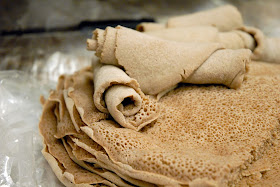Injera is an Ethiopian flatbread. Teff flour can be found at your local supermarket, usually bob's red mill has it for sale. Teff grain is gluten-free and has a bit of a sour taste to it. Injera is a sourdough flatbread, no need to add yeast or any leavening agent. For a traditional breakfast, see how we used this same gluten-free flour to make teff pancakes.
Traditional Ethiopian Teff Injera (Gluten-Free) Servings: 20
Ingredients:
- 3 cups ground teff
- 4 cup water
- Sea salt to taste
- grape-seed oil for the skillet (or avocado oil)
Note: This is a large batch, as I like to have left-overs. Also, the fermentation process takes a while, so it's nice to have some injera for later. For a smaller batch, cut the ingredients in half.
1. Mix ground teff with the water and let stand in a bowl covered with a dish towel at room temperature until it bubbles and has turned sour. The fermentation process will take approximately 1-3 days. The fermenting mixture should be the consistency of a very thin pancake batter.
2. Stir in the salt, a little at a time, until you can barely detect its taste.
3. Lightly oil a skillet 8 inches minimum but you can also use a larger one. Heat over medium heat.
4. Pour in enough batter to cover the bottom of the skillet; About 1/4 cup will make a thin pancake covering the surface of an 8 inch skillet if you spread the batter around immediately by turning and rotating the skillet in the air; This is the classic French method for very thin crepes; Injera is not supposed to be paper thin so you should use a bit more batter than you would for crepes, but less than you would for a flapjack pancakes.
5. Cook briefly, until holes form in the injera and the edges lift from the pan; Do not let it brown, and don't flip it over as it is only supposed to be cooked on one side.
6. Remove and let cool. Place plastic wrap or foil between successive pieces so they don't stick together.
7. To serve, lay one injera on a plate and ladle your chosen dishes on top. Serve additional injera on the side. Guests can be encouraged to eat their meal without utensils, instead using the injera to scoop up their food.
Note: It takes much practice to properly make injera. The equipment you use and the controlling of the heat are crucial.
source via celiac.com, image via blog.generalmills.co


